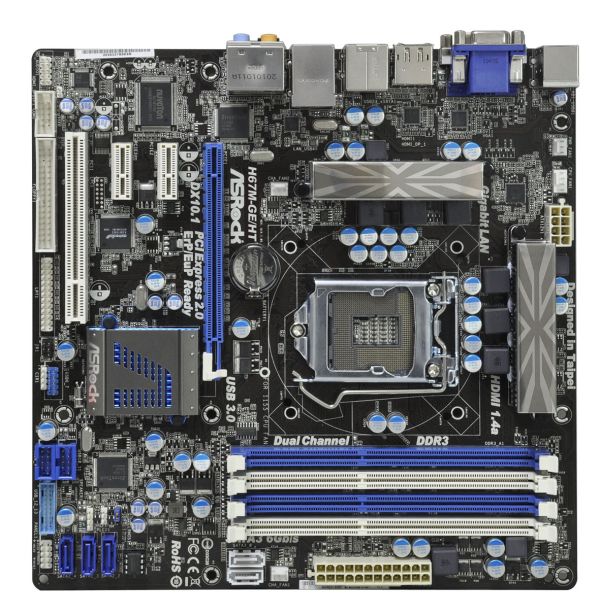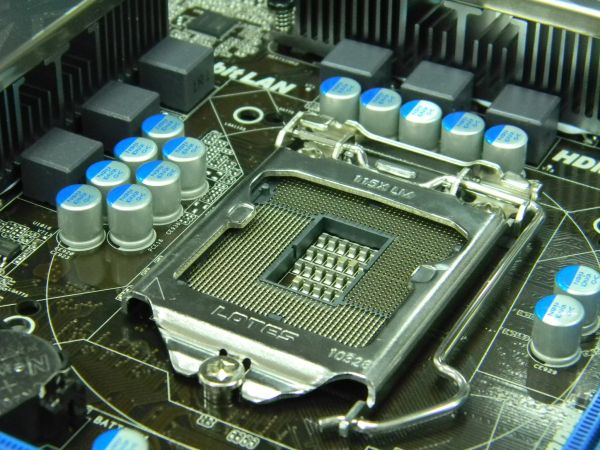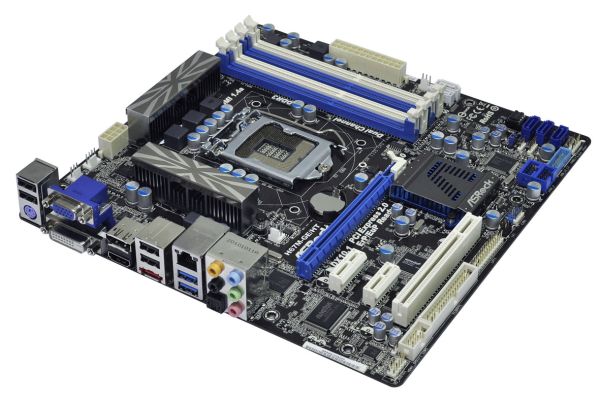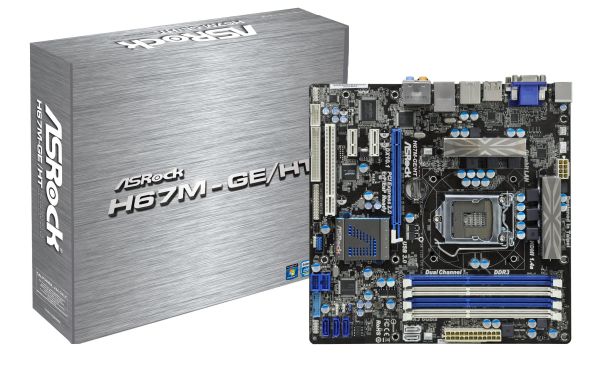H67 – A Triumvirate of Tantalizing Technology
by Ian Cutress on March 27, 2011 6:25 PM EST- Posted in
- Motherboards
- Sandy Bridge
- H67
Overview
ASRock’s H67 lineup consists of 6 boards, ranging from $100 to $140, in both micro-ATX and mini-ITX form. The H67M-GE/HT comes in at $120, and even comes with a USB 3.0 Front Panel with space for an SSD in there. After a blast with the board, I can safely say ASRock were aiming for the midrange.
Of note, the ASRock board falls down on the single thread benchmarks compared to the P67. On further inspection, it seems that in single threaded mode, the full 4x turbo was not being applied, but rather a 3x turbo was in place. It did hit the 4x turbo on occasion, for a minuscule amount of time here and there, but due to the 3x turbo implementation, the ASRock board falls behind. I emailed ASRock about this, and they responded that this is how the H67 is meant to work, which leads to the conclusion that, if the other H67 boards behave similarly, there are more stringent rules on what constitutes a single thread process on the H67 chipset from Intel themselves.
Visual Inspection
Typically, when I see a blue and white motherboard, I think Gigabyte. However, with Gigabyte moving towards a black livery on their high end boards, it leaves another company to barge in on the space – enter ASRock. Maybe blue and white ports are cheaper to produce or something.
One of the first things to notice about this H67 board compared to any others are the small VRM coolers. The board offers a 4+2 digital VRM setup, four fan headers (three three-pin, one four-pin), and standard mounting holes for your 1155/1156 CPU coolers. There are also mounting holes for socket 775 coolers, making that old cooler last even longer. There is enough space to mount a number of large air coolers, or your favorite all-in-one water cooler.
The low profile chipset cooler is used, so as not to interfere with large PCIe x16 cards. With a dual-slot PCIe x16 card, there is still access to a PCIe x1 and PCI slot; however I would have preferred one of the PCIe x1 slots above the PCIe x16. There are five SATA ports on board – two SATA 6 Gb/s (white) and three SATA 3 GB/s (blue). The SATA ports are sticking out of the board, contrary to what we have seen with the P67 boards so far – they are also facing each other, potentially making wiring more difficult if all 5 ports are being used.
We were not expecting debug LED and power/reset buttons on this $120 board, and true to form, none are provided. However, as you will see on the ECS board which comes in at $145 later in this combination review, they do come in on some H67 products. In our P67 reviews thus far however, the cheap ASRock P67 board had the debug LED and power/reset buttons and the more expensive ASUS/Gigabyte boards did not. This time, we are not so lucky. But with H67, maybe we do not need them. We will look into this later.
In terms of legacy connectors, we still have the floppy connector here, and the PS/2 port on the back panel. Onboard ports come in the form of 3 USB 2.0 headers, one USB 3.0 header, and an extra firewire port.
The back panel is not exactly brimming with connectivity, but we are looking at four USB 2.0 ports, two USB 3.0 ports, gigabit Ethernet, eSATA, audio, and quad display outputs – DisplayPort, HDMI, DVI-D and D-Sub.















56 Comments
View All Comments
bupkus - Monday, March 28, 2011 - link
Agreed. The i3-2100 is a true budget cpu, imho. It should be matched with a true budget mobo-- namely the H61. I hope to see some more info on boards made with that chipset.Taft12 - Monday, March 28, 2011 - link
It's not accurate to call the i3-2100 a "true budget CPU" while we've got stuff like the Athlon II X2 and Pentium E5xxx on the market.cjs150 - Monday, March 28, 2011 - link
I am pleased you said this, because this is something I do not understand either, H67 looks to be a waste of timeASrock seems the best of this silly catagory. I have one of their boards in a file server, nice board, just works without fuss. Perfect for a server. May look at them for next build, instead of my usual ASUS fetish.
One thing though that really bugs me. Why on all the Micro-ATX boards out there do they insist on having the top PCI-E so close to the bottom end of the memory sockets. Have the MB manufacturers not noticed that high end memory is shipping with cooling fans? Several times I have found it impossible to fit a graphics card and the memory fan, virtually every time at the very least I have to ensure that there are no possible shorts by putting electricians tape around the bottom of the memory fan clup on. MB manufacturers it is not difficult, move the PCI-E slot down by 5mm or the memory sokets up by 5mm
bigboxes - Monday, March 28, 2011 - link
Not a bash, but fans on DDR3 ram is mostly frivolous waste. Heck, most ram today doesn't even need fancy heatspreaders because they run so cool. This is about the H67 chipset so I don't think many would waste time/money on buying high end memory that offers little in the terms of performance. Don't worry, Z68 is coming soon and you'll be able to buy your full ATX board that you can load up with the latest and greatest in parts to get that XTREME o/c. This chipset is not marketed for you.ArtShapiro - Monday, March 28, 2011 - link
I'd like to think that I (a decided non-gamer) am the target audience.I currently have a physically large (huge?) desktop system in a Chenboro 105 case. No way this monster can fit in the alcove in my computer desk, so it sits on the floor with the usual scads of cables coming from the desk. What a royal pain to move, clean, etc.
I suspect this summer I'll have an H67 system in a tiny (maybe Antec 300-150) case, little bigger than my tiny Asus TS mini Windows Home Server machine. With no graphic card, this thing should be efficient and dwarf the performance of the existing monster.
The H67 setup fits my needs to an alarming degree!
Art
Concillian - Tuesday, March 29, 2011 - link
What about this system cannot be handled by a significantly cheaper H61 motherboard? I missed that part of why H67 was perfect.
Taft12 - Tuesday, March 29, 2011 - link
He's not a gamer, but maybe he wants the SATA 6Gbit ports? 4 memory slots? USB 3.0?H61 boards are lacking, well, a lot if you're want anything beyond ultra-entry-level.
ArtShapiro - Wednesday, March 30, 2011 - link
Pure power. The cost is irrelevant (within reason); the increased processor of, say, the 2500/2500K will be a nice thing in processor-heavy applications and will probably ensure a longer relevant lifetime for the machine.I figure it's worth it to shell out a little more upfront for the H67.
Art
bobbyto34 - Monday, March 28, 2011 - link
Thanks a lot for testing DPC Latency. This can be a major issue for DAW's users.Spoelie - Monday, March 28, 2011 - link
I would concede that an integrated GPU is a very valuable tool for any computer user. It can be used to eliminate variables when troubleshooting a system, and to prevent downtime when the discrete GPU passes away. For this reason and this reason alone I personally don't buy a system without an integrated GPU anymore, even though I always have discrete GPUs. At least in 2 cases this has helped me tremendously.My personal preference is a cheap but good overclocking mATX board with (support for) iGPU & at least 1 eSATA port. Couldn't care less about SLI/XFire & RAID5, so the 785+SB710 board I now use was perfect, but without USB3 and SATA6 it's starting to show its age. One of the reasons I haven't switched to SNB is that Intel can't provide me that platform yet.
Here's to hoping for cheap mATX Z68 and cheap(er) K series CPUs.